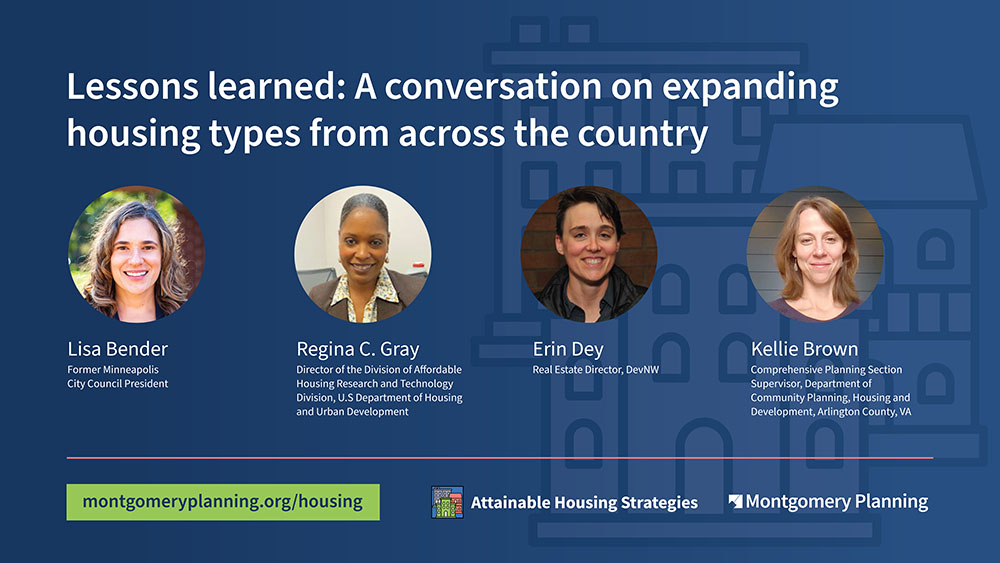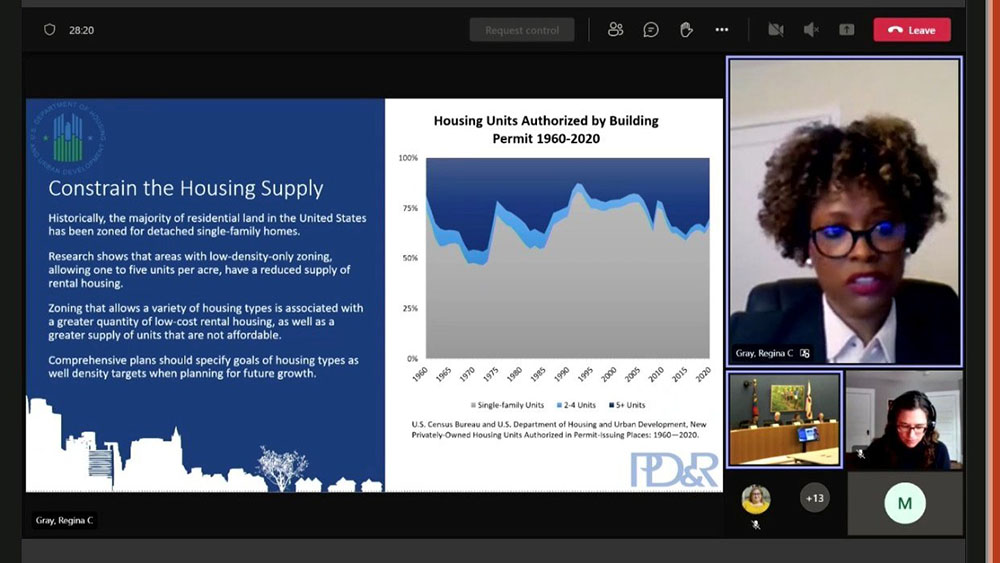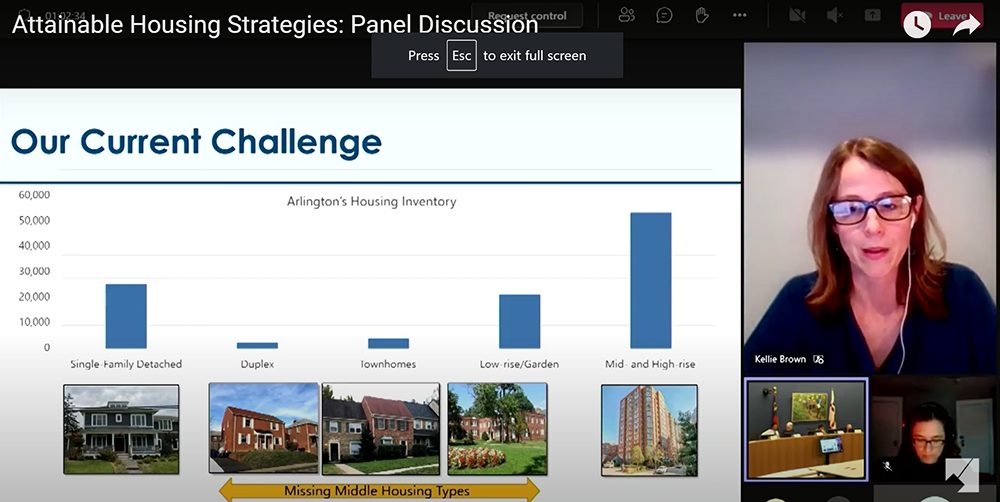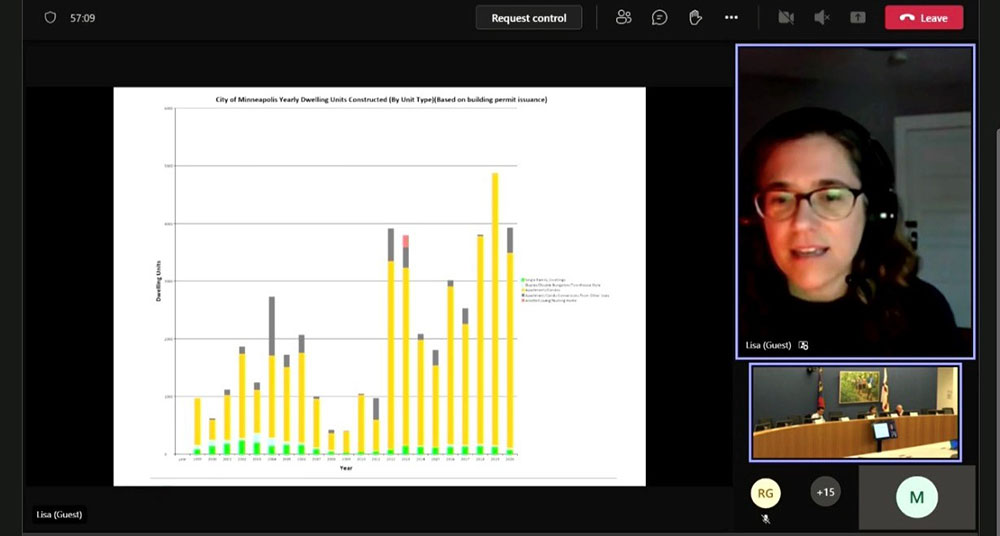By Jason Sartori, Lisa Govoni, and Karen Blyton
It has been widely reported that Montgomery County is facing a shortage of housing options that meet the size, price, and location needs of our increasingly diverse population. This issue is not specific to Montgomery County—places across the country are looking to expand housing types in their area.
To better understand what other regions have done to make homeownership more attainable for their residents, Montgomery Planning held a virtual event during the Montgomery County Planning Board’s February 24 meeting featuring an esteemed panel of housing experts. Called “Lessons learned: A conversation on expanding housing types from across the country,” it featured former Minneapolis City Council President Lisa Bender, HUD’s Regina C. Gray, DevNW (Oregon) Real Estate Director Erin Dey, and Arlington County, VA, Planning Supervisor Kellie Brown.

The Planning Board used this event to examine how states such as Oregon, cities like Minneapolis, MN, and, more locally, Virginia’s Arlington County are navigating creating new housing types and increasing housing choice. The Planning Board engaged in a discussion with the panel to see how the panelists’ experiences and best practices could be applied to Montgomery County and the Attainable Housing Strategies (AHS) initiative. Here is what we learned:

Regina C. Gray (U.S. Department of Housing and Urban Development) discusses constraints to the U.S. housing supply.
Our housing supply is constrained—not just in Montgomery County, but nationwide—due to a prevalence of single-family zoning. This creates barriers to potential homeowners and renters.
Regina C. Gray from the U.S. Department of Housing and Urban Development explained that land use zoning practices can create barriers in the market and price out potential homeowners and renters. Zoning policies can constrain the housing supply, artificially raise prices and reduce affordability, and place limits on diversity. She discussed how most of the residential land in the United States has been zoned for detached single-family homes.
“Zoning that allows a variety of housing types is associated with a greater quantity of low-cost rental housing, as well as a greater supply of units that are not affordable,” said Gray. “Our goal is to expand the supply of moderate-income housing and there are several solutions to this. Comprehensive plans should specify goals of housing types as well as density targets when planning for future growth.”
Kellie Brown, Comprehensive Planning Section Supervisor for Arlington County, VA, says that her county is also facing a lack of diverse housing options due to single-family zoning. Since the fall of 2020, Brown has been part of the Missing Middle Housing Study. Through this study, Arlington County is looking at a range of housing types in the middle between single-family detached houses and mid-to-high-rise apartment buildings, such as smaller houses with lower associated costs, three-bedroom units, and starter homes.
The Planning Board’s Attainable Housing Strategies recommendations will identify zoning reforms to allow and encourage the creation of a more diverse range of housing typologies across the county. During its next Attainable Housing Strategies work session (tentatively scheduled for May), the Planning Board will review potential zoning modifications that would implement the numerous recommendations contained in the Draft Attainable Housing Strategies Final Report. However, the recommendations should be viewed as providing a menu of options for the Council to consider, which can be implemented by introducing and adopting relevant portions of the corresponding zoning modifications.
“What we are finding is that the decades of zoning policies that discourage or ban smaller scale, higher density housing have contributed to the ‘missing middle’ gap.”
Additionally, the Planning Board’s recommendations support Montgomery County’s regional housing targets, which the Montgomery County Council adopted in 2019. “What we are finding is that the decades of zoning policies that discourage or ban smaller scale, higher density housing have contributed to the ‘missing middle’ gap,” said Gray. “This is reducing housing choice and is placing a particular burden on low- and moderate-income families.”
Erin Dey, a Real Estate Director at DevNW, a community-based economic development corporation located in Western Oregon supported this idea. “Wages are not increasing at the same rate as housing costs,” said Dey. “The lack of housing diversity and housing typologies is a key player in keeping people from owning a home… expanding housing typologies is key.”

Kellie Brown (Arlington County Department of Community Planning, Housing and Development) presents the current challenges of Arlington’s housing inventory.
There is not just one solution to any community’s housing problems. Issues must be addressed in a comprehensive way.
Our panelists illustrated throughout the event that there is not one single answer to any community’s housing issues. When the Minneapolis City Council was reviewing its housing situation, there were not enough homes for the city’s growing population. The city also lacked a variety of housing options for immigrants and seniors who wanted to age in place and was experiencing growing racial disparities in housing. Additionally, there was a lot of pressure placed on renters in a city where 52% of households were renters. How is the city combatting these issues? Through multiple tools and policies, as no one solution can tackle all of these problems.
During the panel event, former Minneapolis City Council President Lisa Bender discussed how Minneapolis’s comprehensive approach to housing policy was adopted in 2018 as part of the city’s master plan, Minneapolis 2040. Through this plan, the city legalized triplexes citywide, created inclusionary zoning requirements for market rate projects, eliminated parking minimums citywide, and added renter protections. The city implemented a series of policy changes to make housing more attainable for residents.
Like Minneapolis, Montgomery Planning staff and the Montgomery County Planning Board have reviewed the county’s housing attainability issue holistically and have offered multiple tools to create more diverse housing types. In addition to providing the Montgomery County Council with potential zoning modifications, the Draft Attainable Housing Strategies Final Report includes:
- Allowing more housing options: Allowing the creation of duplexes and triplexes in many neighborhoods that currently only allow single-family detached units by-right.
- Leveraging transit: Establishing a Priority Housing District surrounding key transit corridors to allow reduced parking requirements and the construction of quadplexes in more walkable, transit accessible neighborhoods.
- New optional method of development: Creating a new Attainable Housing optional method of development to spark medium density and more diverse types of buildings like small apartment buildings and stacked flats in residential areas along corridors.
- The Master Plan process: Leveraging the master plan process to identify opportunities for rezoning properties along the county’s primary corridors to allow higher density residential development.
- Parking: The Planning Board agreed to reduce minimum off-street vehicle parking requirements for attainable housing units but acknowledged that other options could be considered.
- Catalyst Policies and Programs: The Planning Board recommends that the county explore several additional policies and programs to encourage the production of attainable housing. These policies include ones that would assist existing homeowners who wish to convert their homes to a duplex, triplex or quadplex, and other community-level incentive programs. The Board recommends that these ideas be studied through multi-agency efforts after implementing any zoning reform.
The final AHS report will be transmitted to the Montgomery County Council in 2022 following final Council action on Thrive Montgomery 2050, which includes a general framework to address the county’s housing shortage. As called for in Thrive Montgomery 2050, the Planning Board believes that the AHS policies and programs should be pursued as part of a comprehensive housing approach along with efforts aimed at preserving existing affordable housing, supporting the production of new low-income housing, eliminating homelessness, and reducing the cost of housing through innovative construction methods and materials.

Lisa Bender (former Minneapolis City Council President) presents on the number and type of dwelling units built in the City of Minneapolis by year.
Changes to housing and zoning policies will not dramatically impact housing overnight—it will likely create very incremental changes to communities over time.
Actual change in Minneapolis’s neighborhoods has been incremental, despite community concerns that the city’s new zoning policies would create change too quickly.
“For the first couple of years, 60 duplexes and 15 triplexes were added in a city of just over 400,000 people,” said Bender.
She explained during the event that moving the needle on housing policy can be challenging for government. “Unlike transportation or infrastructure where we have direct control, here we are interacting in a private market,” said Bender.
While the additions of new housing types have not been dramatic, she is hopeful that the city is moving in the right direction. “The biggest change we have been seeing is more 20-to-100-unit buildings, these smaller buildings that were not permitted before because of parking or setback requirements,” said Bender. She added that they had “essentially been illegal” before the change.
As a result of the new zoning laws, “we are starting to see more smaller developers and a greater diversity of developers,” said Bender.
The Planning Board’s Attainable Housing Strategies recommendations are meant to allow for the creation of different housing types to make single-family neighborhoods accessible to more households. Like in Minneapolis, change will likely not happen instantly. It will take time. But implicit in attainability is the idea that a range of housing options (type, size, tenure, cost) exists in the local market. Attainable housing includes a focus on diverse housing types beyond single-family detached units that tend to be smaller and more affordable than the typical new detached home in that neighborhood.
“We often think of zoning changes like they are etched in stone… it is okay to adjust it in six months or a year.”
Watch the full housing panel on Montgomery Planning’s YouTube channel.
 About the authors
About the authorsJason Sartori is the Chief of the Countywide Planning and Policy Division, which focuses on Montgomery County’s countywide planning efforts, including: transportation planning, transportation networks and modeling, public infrastructure adequacy monitoring (including schools), environmental resources, historic preservation, Vision Zero, zoning and housing policy. Jason joined the Planning Department in 2016, and has since helped lead two updates to the county’s adequate public facilities ordinance, known as the Growth and Infrastructure Policy. Jason previously served as the Associate Director of the National Center for Smart Growth at the University of Maryland.

Lisa Govoni is the Housing Policy Coordinator at the Montgomery County Planning Department, part of The Maryland-National Capital Park and Planning Commission (M-NCPPC). Lisa serves as the lead on major housing-related projects, including long-range sector planning activities and policy and zoning changes related to housing. Lisa completed her BA in Government and Politics in 2008, her MCP in Community Planning in 2011 and her MPS in Geographic Information Systems (GIS) in 2013, all from the University of Maryland, College Park.

Karen Blyton is a Content Manager for Montgomery Planning’s Communications Division. In this role, she develops communications materials for Montgomery Planning’s website, social media channels, eLetters, and blog to help engage the community in the planning process. She brings with her 10 years of communications experience from a variety of non-profit and governmental organizations, such as the DC Sustainable Energy Utility, the Association of American Medical Colleges, and most recently, RTI International. She has a Masters of Professional Studies in Public Relations and Corporate Communications from Georgetown University.
Cheryl Gannon
This panel discussion did not produce any data to support the idea that implementing the attainable strategies policies will achieve the stated goals. Data and studies from other jurisdictions showing that upzoning without other tools can increase land values and prices and lead to less diverse communities was not presented. Panelists were chosen because they are aligned with the Planning Board’s preconceived goals. Arlington is only just beginning the process and has no data to share on results; Minneapolis experience thus far is not encouraging– with absentee landlords buying single family homes to turn into rentals making single family homes for sale more scarce and home ownership more of a challenge for average folks. In Oregon, the program was designed to reach a low-income population with supports and tools not even contemplated by Thrive.